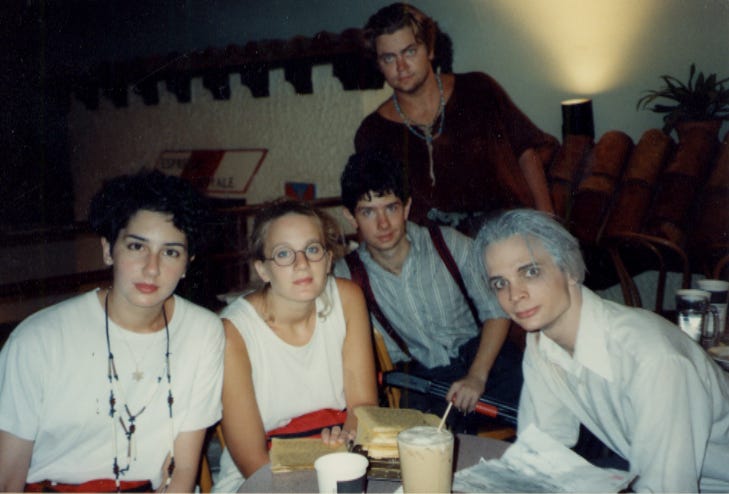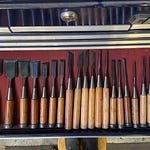Will Hindmarch of Chicago, Illinois writes,
“Hello there, sir! It is well known in my circles that you partook of tabletop roleplaying/story games like D&D, etc., in days past. My question is sort of many-headed: When and where was this time in your life *and* how has creative, narrative play affected your creative, narrative work or outlook on it? That is, how do you divide work and play, and why is that? Thanks for this opportunity to ask. Cheers from Chicago.”
Thank you, Will, for this evocative question, and please give my best to Moody’s Pub, home of mysteriously intoxicating stacks of bread, meat and cheese, washed down with tankards of the darkest ale, if you get the chance. And what a garden, when the weather’s right. Just off the Thorndale stop.
I believe Dungeons & Dragons landed in my friend group in 1982 or so, and we were simply enraptured by the incredible fecundity it fertilized in our imaginations. My dear friend and neighbor Mike and I especially loved to create characters, rolling the assorted dope-decahedron dice shapes to discover the number of hit points or amount of charisma that was possessed by our clerics, monks, fighters or paladins. I spent countless hours designing outfits and drawing elaborate two-handed broadswords destined, I thought, to become legendary magical smiters like Glamdring or Excalibur.
Honestly, we weren’t very good at D&D. We didn’t have a proper DM (Dungeon Master to you uninitiated), but we loved stumbling through store-bought modules and learning about spells and magical objects like a (bottomless) bag of holding, a vorpal dagger (cuts through anything), or a conceptual hole/portal that you could pull out of your pocket, drop on the ground, then jump into and disappear. I was also quite taken with the weirder monsters, like the Umber Hulk, the OwlBear, the Gelatinous Cube and the Shambling Mound.
Around ‘84, one of our gaming gang (Trent!) got a shiny new Apple IIe computer, so we shelved our dice and colored pencils and huddled around the monitor of this incredible technology to play a text adventure game called Wizardry. By “text”, I mean the game was only spelled out in typed language, as opposed to possessing a visual element as well. Hanging on every letter, three or four of us would gasp and holler at the twists and turns that played out in mere…sentences. It was pretty damn thin, in hindsight, but it had its claws in us.
The Game: AS YOU PROCEED DOWN THE TUNNEL THE ROCK SURFACE BENEATH YOU GROWS SPONGY. A RANCID BREEZE EMANATES FROM THE END OF THE TUNNEL IN FRONT OF YOU.
Us: GO BACK.
We were not able to communicate our desires with much detail, like “Ok, then we hold our noses, turn around, get the fuck out of there and go back to that Brandywine Tavern”. Instead, we were relegated to simple commands, like Right, Left, Forward, Back, etc. But I’ll remind you, this was in about 1984. Vinyl wasn’t cool yet, or retro, it was still just simply the badass music delivery medium it has always been, with its weird little friend the tape cassette still emerging. So the computer seemed like some miraculous calculator, or digital watch on steroids, that could now take you on a mind journey into a fantasy realm?! Mind-blowing.
Looking back on this time, I wonder what creative growth I actually lost to that Wizardry game. It’s predecessor was a game called Zork, which I had seen in the computer lab at school, where we had maybe four Apples and another six or so TRS-80 computers from Radio Shack. The thing is, whenever I had a structure within which to create, like the D&D character sheets, or a sword on graph paper, my imagination thrived and ran through its own organic algorithm, or “algorganorithm” to find the unique details that thrilled me.
In the same way, I was exploring the structures of other arenas in my life. Like church. Classrooms. The school bus. The baseball diamond. The family dinner table. In each of these discrete settings, I was subconsciously running my algorganorithm to discern what behavior I a) found most entertaining, and b) could get away with. Pressing and teasing the boundaries of this equation became a bit of a lifelong practice, for better or worse, but I think mostly better. Eventually.
Throughout my high school years my allotted role-playing-game time was largely supplanted by sports and trying to learn how to have sex (even well after I had started having sex). My penchant for acceptable mischief—how much could i get away with?—continued to explore every nook and cranny of every space I inhabited, like an expanding, roiling cloud of joke.
It was then I also discovered the ultimate experience in role-playing, that wasn’t a game at all, but instead literally just playing roles—in the school plays and musicals. Obviously, I took to it like a cow to grass, discovering all of the inner stutter-steps and sashays that I would spend years teasing out, and I don’t believe I ever played the table version of an RPG again in my life.
However, when I got to theatre school at the University of Illinois at Urbana-Champaign, I met some fellow nerds, and I mean we were the sweatiest of geeks for our particular obsessions. The plays of Samuel Beckett and Harold Pinter. Memorizing every last lyric of every They Might Be Giants song. Learning as much as we could about hefeweizen beer from Germany, the lemonade of beers. Like for example, “hefe” means “yeast”, and “weizen” means “wheat”, so you’re welcome, now you can dazzle your family at dinner tonight. Everybody should be a sweaty nerd about something, it’s the rich, multi-flavored nectar of life.
A handful of us (mostly undergrad) theatre nerds who also had some assorted RPG experience found ourselves recruited by a graduate acting student who turned out to be a goddamn genius for creating delightful and nefarious pastimes. His name was Andrew Leman, from Colorado, and he had brought with him an activity of which I had not heard, but was about to be entirely swept away by, as though it were an irresistible cult. Get this: Live. Action. Role. Playing. That’s right, my Muleteers, your correspondent was about to become a full-on LARPer. If you’re not familiar, LARPing is a lot like Civil War reenacting, except instead of Yanks and Johnny Rebs and black powder weapons and Patrick Swayze wannabes, you have wizards and barbarians and fireballs and Patrick Stewart wannabes.
The source material for our particular pageants? The horror fiction of one H.P. Lovecraft, who, thanks to the terrifying mythos he constructed around the eldritch alien creature Cthulhu and that being’s compatriot “Old Ones”, was considered by many to be the “father of modern horror fiction”. Lovecraft was a master at teasing the most extreme terror out of a narrative by refusing to identify what exactly was lurking in the darkness of his tales, thereby allowing his readers’ imaginations to offer up a more succinct and poignant horror than any monster he could have described. Old Howard Phillips Lovecraft was also a virulent racist, which I’ll address a bit later.
Andrew Leman was, and is, a walking juggernaut of talent. Besides being an excellent cook and five-star hugger, he was likely the best actor in the U of I program, with an array of foreign dialects at his immediate disposal and a nimble command of his physicality that served him admirably in assaying all manner of roles, from a fabulous French fop to a deadly katana-wielding samurai in Rashomon, but that was just the beginning. In his spare time, he would make astonishing things with his hands. Mostly in the realm of props, costumes, puppets and such, but with exquisite, delicate skill, the sort that has always made me weep with envy, as though he was able to stitch charm itself into the very fabrics he was manipulating. And, even better, he was batshit crazy in the positive way all of us obsessive makers aspire to be.
Like, for example, he once bought an enormous bag of tiny steel split rings, and utilizing only two pair of needle-nose pliers, he opened and closed the rings onto each other in a painstaking, meticulous pattern until he had woven an entire shirt of chain mail. He’s still not quite right to this day. I love him to death.
Part of the reason I adore him is because of these LARPing adventures he would concoct. These were the brainchildren of Andrew and his lifelong pal Sean Branney, who he met during high school in a Denver-area production of A Man for All Seasons. I mean, what an appropriate origin story for the two godfathers of my frightful mirth. A table-top role-playing game called Call of Cthulhu was their gateway to the dark mental hallways of H.P. Lovecraft. They and some college friends, aspiring, perspiring thespians all, would have the idea to take these adventure/horror stories, mostly set in and about Lovecraft’s fictional New England town of Arkham, Massachusetts (yes, they did have an asylum there, why do you ask?), and manifest them up off the gaming table and onto their feet, breathing actual life into them until they weren’t playing out the quests in their collective minds—they were engaging with these thrills bodily, in real life.
Cut to: four or five years later, in central Illinois, where Andrew had perfected the form, as he would outline the narrative of each adventure, then fabricate the featured props and spells and scout the appropriate locations, and cast two groups of willing weirdos: the players, who would act as the investigators of whatever wrongdoing comprised the core of the adventure, and the NPCs, or non-player characters, with whom the players would interact in different scenarios in the world of the game, but who also knew what was happening behind the scenes.
Add to this mix the resources of a really nice state-funded college theatre department, meaning vaults full of costumes, the means and facilities to fabricate really whatever we needed, because theatre professors? They’re just slightly older sweaty nerds in their own right. They would often help make us specialty weapons and spells and effects, even if they weren’t suiting up and playing themselves.
It was just a fantastic template within which a number of full-bore occult enthusiasts could go hard, for days at a time, so we enthused like it was a sickness.
Even as I was going to school during the day, matriculating with the specific intent to become a professional actor, I was in the woods at night, following an enchanted black scroll tracing a puzzle of runes that would hopefully lead us to the seventh of the nine talismans we needed to assemble before the demon regained access to this plane! It was so exhilarating, especially in collaboration with like-minded play-actors, and so taught me a different set of valuable lessons than the ones I got in the classroom.
I was learning that, even once the years of “childhood” had ended, I could still get together with friends, and, by god, play at anything I chose. And that the quality of that play, executed with the experience and resources available to an adult, or better yet, a group of them, was conclusively even more fun than if we had been a bunch of so-called kids. In fact, I would argue the more responsibility, the more pressure, that one bears in one’s “adult” life, the more giddily fun the playtime can end up being, if a body can throw oneself into the fray with absolute abandon.
The games in which I got to partake with Andrew, his sometime writing partner Jamie, and the rest of us many willing disciples were some of the greatest gifts of my young life. And I didn’t squander them, Will Hindmarch of Chicago. So to clean up your final question: How do I divide work and play, and why?
Thanks to the whimsy and camaraderie in my collaborations with the Cthulhu team, and also with my theatre family (who would shortly be founding our own company, Chicago’s Defiant Theatre), a healthy dollop of hard work, and a couple more scoops of luck and white boy privilege, I was able persevere in making my play and my work one and the same. Even now, I still spend my working hours exploring my sphere to delineate the boundaries, so that I may then tweedle dum out a stupid dance on or about the border of the box or the envelope or, well, common decency. You’ve seen my work. I’m exercising my algorganorithm.
Whether I’m acting or making people laugh on tour, writing a book or this essay, or building something good in my shop, my job is usually what I also consider my fun. I know how lucky that is and that’s why I mind my manners as hard as I can.
Love,
p.s. Andrew and Sean are also recipients of the same kind of luck, as they make their respective livings running a pretty fantastic company called the H.P. Lovecraft Historical Society, where they make all manner of top-drawer props, documents, radio dramas of Lovecraft stories, full-on motion pictures, and absolutely hordes more cool stuff. It’s simply bonkers how much high quality original content they have cranked out over the years, even as the quantity continues to rise as well. Perhaps their secret lies in the company motto: Ludo Fore Putavimus, or “We thought it would be fun.” Heroes.
Ahem. Andrew has also made several dozen fonts from scratch—think about that for a second. He makes fonts. Like look at this Q here. Imagine designing just that. Now imagine doing the whole alphabet, in big and wee case. Plus numbers and symbols, I mean, design this shit: &. What?! He’s a freak.
Well worth a stroll through: HPLHS.org
p.p.s. I’ll turn to the aforementioned website to take my rest upon their eloquent coat-tails as they answer the question of countenancing Lovecraft’s racism: https://www.hplhs.org/faq.php

My generous Muleteers, I am sincerely grateful for the carrots you provide, and in more forms than just the skinny, orange kind. I’m enjoying this writing experiment, and I hope you are too. This one didn’t have as much chuckle-fare, but it’s because the question got me very sweaty to talk about some dead serious LARPing matters.
Soon there will be wonders like you never imagined available only behind the paywall. Don’t try and imagine them, because like I just said, you can’t. Is that a bad thing or a bad? Or medium. One way to find out, soldier.
Text version will always be free.


























